This 16-bore pinfire emerged recently and instantly raised my interest. It carries the name 'Thomas Bissell, 75 Tooley Street, London' on the rib.
However it is clearly a continental piece and appears most likely Belgian, dating in style from the late 1850s to the early 1860s. That observation ties in with Bissell's address, which changed to 75, Tooley Street in 1858.
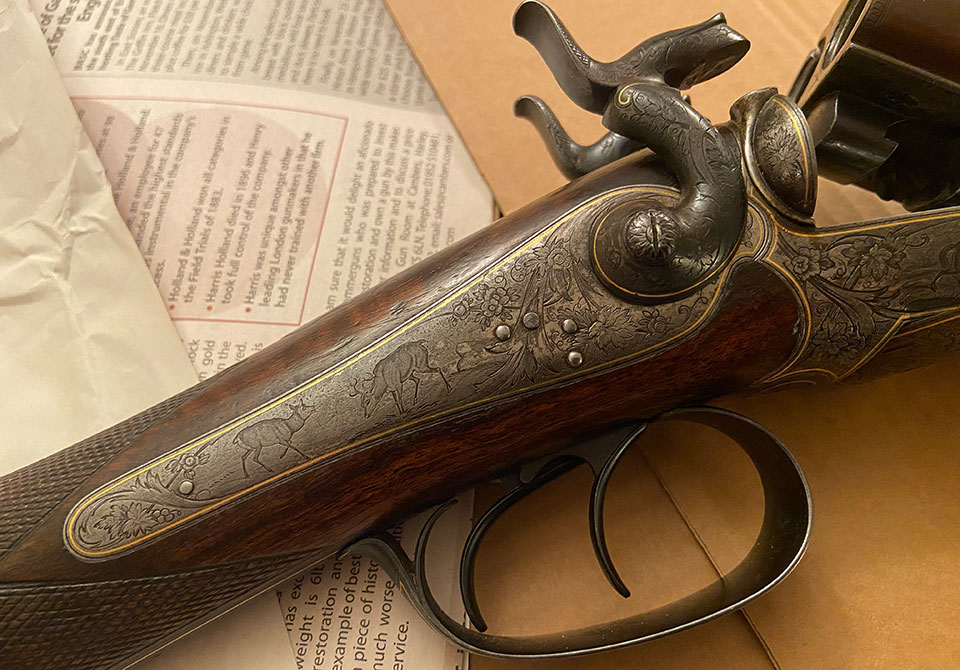
The gun was bought from a family in London who had oral history in the family that it had been bought at the Great Exhibition in 1851. As that was the event at which the pinfire was first displayed to the British public, by Casimir Lefaucheaux, it may have some truth to it, as almost any pinfire then in the country would have been of continental origin.
However, the Great Exhibition was a trade show, not a retail opportunity, so it is unlikely that a visitor would have bought the gun at the Crystal Palace. However, might he have seen one there and put in an order? If that person was Thomas Bissell, might he have seen its potential and acquired one following the show?
If he did, perhaps he re-barrelled it and had it proof tested at the London proof house, for it bears London View and Proof marks, not Belgian ones.
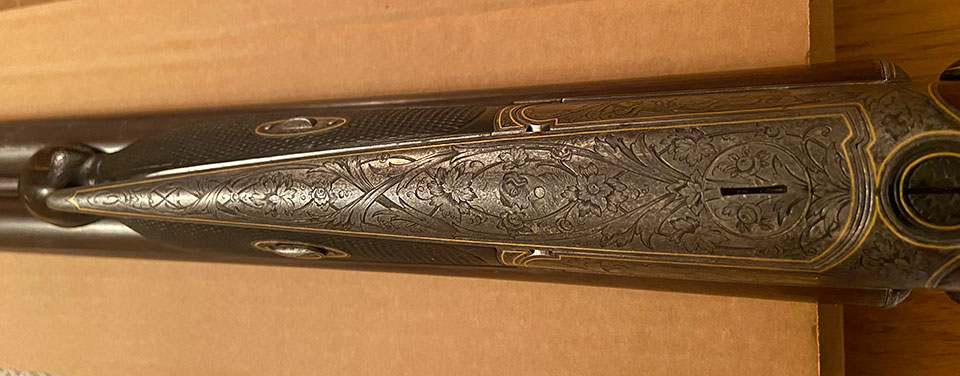
The gun is of good quality and is finished and engraved in the continental style. This is not an action bought in the white and stocked, barrelled and finished in England. It is, however handsome and elegant, handles and shoots well and would have impressed an 1850s audience with its rapidity of fire and nice shooting qualities.
It is certainly much better than the 1863 Joseph Lang pinfire I own, which is widely believed to be the first run of post-Exhibition British pinfires to hit the market. That gun has a forward facing underlever but feels far more flimsy and is of lower quality than this gun.
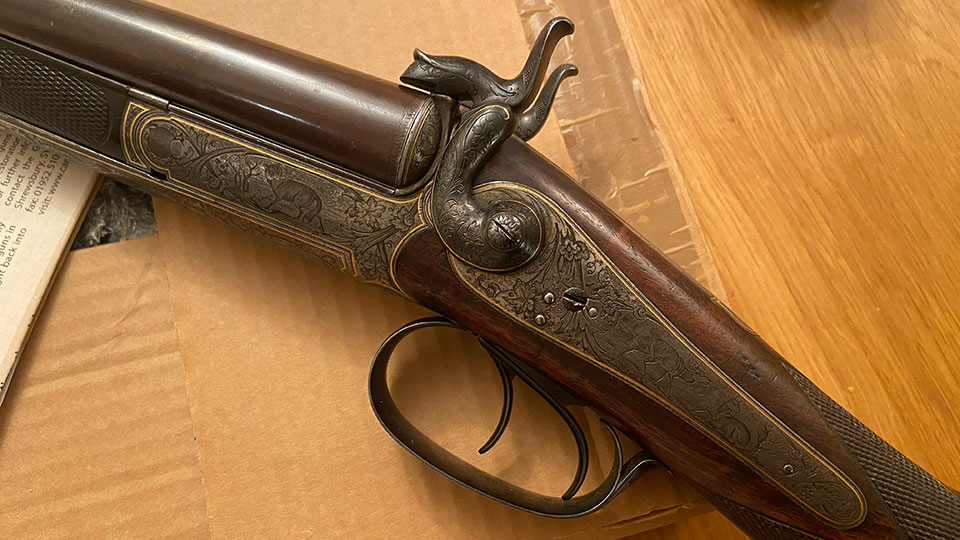
When I first saw it, I wondered if it were a fake. However, why would a faker put the name of a little-known gunmaker to the trade on the rib and bother to research his address? Fakes normally carry the name of a famous maker in order to catch the public imagination.
If this gun is an 1858 Thomas Bissell, even if he only barrelled it, or re-barrelled it, it is interesting. Bissell was thirty years old in 1858 and seven years into his post-apprenticeship career as a gunmaker. He was an inventive man, with his 1866 extractor and his 1878 vertical bolt patents still ahead of him.
His name is not mentioned in the early litearature about the introduction of pinfire to Britain but that does not mean he was not involved. As a twenty-one year old gunmaker in London, he would surely have visited the Great Exhibition and taken a keen interest in the new types of gun on dispaly, though he is not listed as an exhibitor himself (his soon to be collaborator John Rigby was).
This gun is likely to elicit more questions than it does answers for some time. If readers have any observations, I would be pleased to entertain them.
It has already prompted Stephen Nash to offer the following thoughts:
When looking at the history of the pin-fire system in Britain, nothing is murkier than the first few years, where known facts are few and oral histories, presumptions, and contemporary accounts collide, contradict and confuse. No one back then wrote down the details I long for today. Casimir Lefaucheux’s pin-fire invention was patented in France in 1835, and by 1850, it was widely produced by many, if not most, makers in that country. Belgian gunmakers have always been quick to copy and produce innovations from their neighbours so that Liège-made pin-fire guns would have been circulating on the Continent long before the Great Exhibition in 1851. We know Continental breech-loaders were present in Britain.
Francis Russell, the 7th Duke of Bedford, was given a 16-bore Casimir Lefaucheux pin-fire game gun by his mother in 1837. While this gun might have been the first recorded on British soil, others would have been around by 1851, if only as curiosities. The breech-loader was known to British gunmakers before 1851; in the 2 July 1859 issue of The Field, an irritated John Henry Walsh, the editor of the sporting paper, decried: “the Lefaucheaux gun, [sic] which has suddenly come into general use in England, had lain dormant for twenty years, though it was well known to our principal gunmakers, who for some reason or other rejected it as not to be compared with the ordinary percussion gun.” We know Joseph Lang was the first gunmaker to offer a British-made breech-loader, around 1853 or 1854, by his own account.
The system was Lefaucheux’s, but Lang’s action copied elements of Beatus Beringer, another Parisian maker. Who was second? Third? Fourth, etc.? Most likely, John Blanch and E. M. Reilly figure in there somewhere, but who else was quick to get involved? How rapidly did Birmingham workbenches build breech-loading actions and guns to compete with or supply the London trade? And just how many Continental-made guns were in circulation in Britain during the first years before British makers had the production capacity to meet a growing demand?
Written accounts for the period are frustratingly confounding, as terminology lacked precision. Every pin-fire was called a Lefaucheux, whether made by that firm or not or made in France, Belgium or elsewhere. To make things worse, British makers sometimes referred to their breech-loaders as ‘Lefaucheux’ in their record books. And any under-lever, whether forward- or rearward-facing, was named a ‘Lefaucheux lever’ well into the 1860s. While some early user testimonials in The Field referred to Continental guns, it was never made clear if these applied to guns imported from the Continent or Continental-made guns retailed by British gunmakers.
Under the Gun Barrel Proof Act of 1855, any gun sold in Britain had to have British proofs, either added to foreign marks or with the foreign marks removed. In practice, some Continental-origin guns were sold by British makers without the requisite proofs.
One example is this 12-bore signed “Masu Brothers London,” for Gustavus Masu, of 3a Wigmore Street. One brother remained in Liège and presumably oversaw the making of the gun, to be retailed in London; the gun has Belgian proofs but no British marks. Unsurprisingly, in March 1866, Masu was convicted by the Marylebone Police Court of an offence under the Act for selling guns without British proof, for which he was fined five pounds.
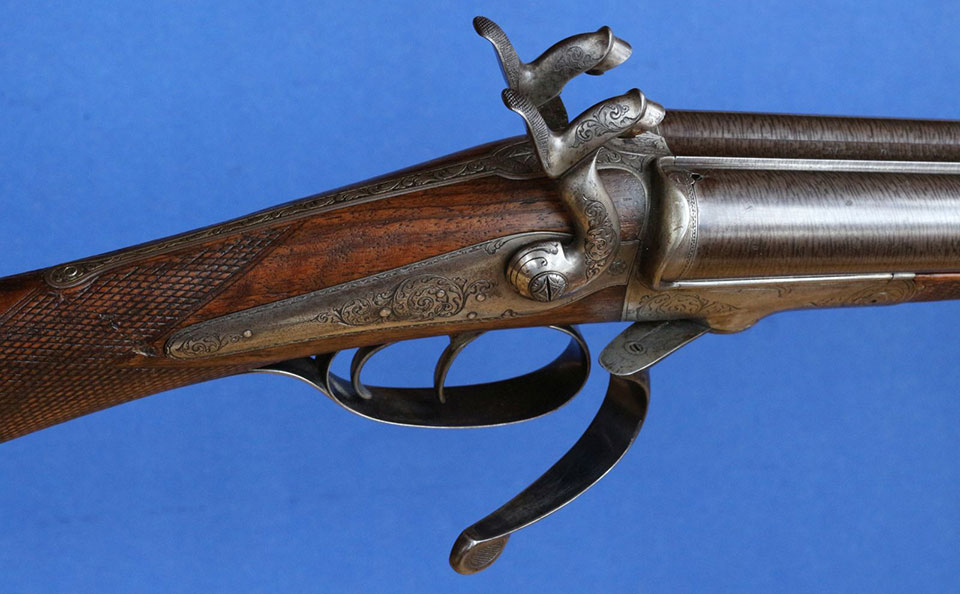
While most barrel tubes used in the trade were already sourced from Belgium, another possible source of confusion over origins was the practice of gunmakers importing barrelled actions instead of finished guns, and stocking and decorating the guns to British tastes. Did the owners refer to these as British guns or Continental? All of these questions are impossible to answer now.
This brings us to the Thomas Bissell pin-fire game gun illustrated in the latest issue of The Vintage Gun Journal. It is a fine-looking piece; without the benefit of handling the gun, it certainly looks Belgian in style.
I suspect the only British element of the gun is the name and address on the rib, which could have been added when the gun was submitted to the London Proof House and before the final finishing of the barrels. If I had the privilege of examining the gun first-hand, I would look for two things on the barrels. The first would be a bore mark in millimetres (which would be around 18.6 for a 12-bore), as this mark was sometimes ignored while foreign proofs were removed.
The other would be if there is a slight shoulder at the junction of the chamber and the internal bore, as was the practice in early Continental pin-fires. Concern over this shoulder causing windage or somehow impeding the travel of the wadding and shot was much discussed in the pages of The Field, leading to gunmakers smoothing this junction into what we know today as the forcing cone. While many guns having this shoulder were reworked by gunsmiths,
I would nevertheless look to see if it is present. It is only as such guns appear out of collections that we can piece together what was available to sportsmen in the mid to late 1850s and early 1860s, when the pin-fire game gun was the most technologically advanced and fashionable sporting gun on the market, even if only for the briefest moment.
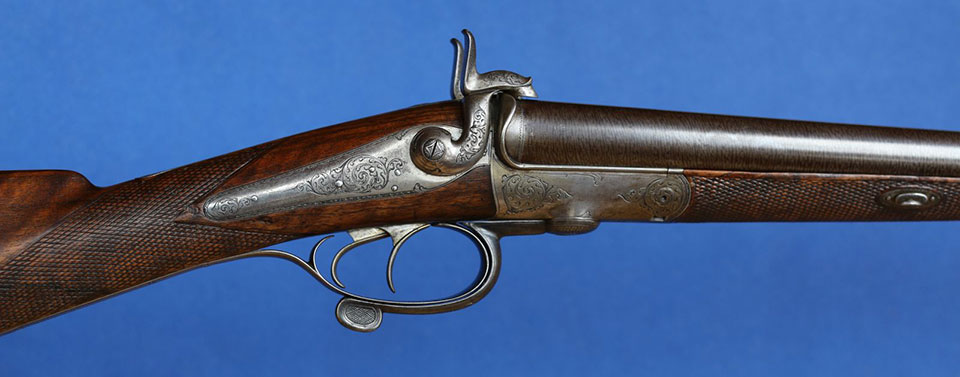
The Bissell gun shows that quality Continental guns were retailed for the British market, and their characteristic decoration style was no deterrent. Such guns were also less expensive than their London and Birmingham counterparts. While the cost of breech-loaders was not a concern to the wealthiest of clients, it certainly was important to many sportsmen, and the savings to be had with a Continental gun was frequently brought up in letters.
It should be mentioned that in the early years of the pin-fire system in Britain, only foreign-sourced cartridges and unfilled cartridge tubes were available, and these fit better in Continental-sized chambers and were less likely to get stuck or split if contemporary accounts are to be believed, with British-made guns being hit-or-miss on that account.
Published by Vintage Guns Ltd on (modified )




